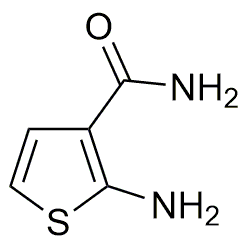2-Aminothiophene-3-carboxamide is widely utilized in research focused on:
- Pharmaceutical Development: This compound serves as a building block in the synthesis of various pharmaceuticals, particularly those targeting neurological disorders, due to its ability to interact with specific receptors in the brain.
- Agricultural Chemicals: It is employed in the formulation of agrochemicals, offering potential as a pesticide or herbicide, which helps in improving crop yield and protecting plants from pests.
- Material Science: The compound is used in the development of conductive polymers and materials, enhancing the performance of electronic devices and sensors.
- Analytical Chemistry: It acts as a reagent in analytical methods, aiding in the detection and quantification of various substances, which is crucial for quality control in manufacturing processes.
- Biochemical Research: Researchers utilize this compound to study enzyme interactions and metabolic pathways, providing insights that can lead to innovative therapeutic strategies.
General Information
Properties
Safety and Regulations
Applications
2-Aminothiophene-3-carboxamide is widely utilized in research focused on:
- Pharmaceutical Development: This compound serves as a building block in the synthesis of various pharmaceuticals, particularly those targeting neurological disorders, due to its ability to interact with specific receptors in the brain.
- Agricultural Chemicals: It is employed in the formulation of agrochemicals, offering potential as a pesticide or herbicide, which helps in improving crop yield and protecting plants from pests.
- Material Science: The compound is used in the development of conductive polymers and materials, enhancing the performance of electronic devices and sensors.
- Analytical Chemistry: It acts as a reagent in analytical methods, aiding in the detection and quantification of various substances, which is crucial for quality control in manufacturing processes.
- Biochemical Research: Researchers utilize this compound to study enzyme interactions and metabolic pathways, providing insights that can lead to innovative therapeutic strategies.
Documents
Safety Data Sheets (SDS)
The SDS provides comprehensive safety information on handling, storage, and disposal of the product.
Product Specification (PS)
The PS provides a comprehensive breakdown of the product’s properties, including chemical composition, physical state, purity, and storage requirements. It also details acceptable quality ranges and the product's intended applications.
Certificates of Analysis (COA)
Search for Certificates of Analysis (COA) by entering the products Lot Number. Lot and Batch Numbers can be found on a product’s label following the words ‘Lot’ or ‘Batch’.
*Catalog Number
*Lot Number
Certificates Of Origin (COO)
This COO confirms the country where the product was manufactured, and also details the materials and components used in it and whether it is derived from natural, synthetic, or other specific sources. This certificate may be required for customs, trade, and regulatory compliance.
*Catalog Number
*Lot Number
Safety Data Sheets (SDS)
The SDS provides comprehensive safety information on handling, storage, and disposal of the product.
DownloadProduct Specification (PS)
The PS provides a comprehensive breakdown of the product’s properties, including chemical composition, physical state, purity, and storage requirements. It also details acceptable quality ranges and the product's intended applications.
DownloadCertificates of Analysis (COA)
Search for Certificates of Analysis (COA) by entering the products Lot Number. Lot and Batch Numbers can be found on a product’s label following the words ‘Lot’ or ‘Batch’.
*Catalog Number
*Lot Number
Certificates Of Origin (COO)
This COO confirms the country where the product was manufactured, and also details the materials and components used in it and whether it is derived from natural, synthetic, or other specific sources. This certificate may be required for customs, trade, and regulatory compliance.


